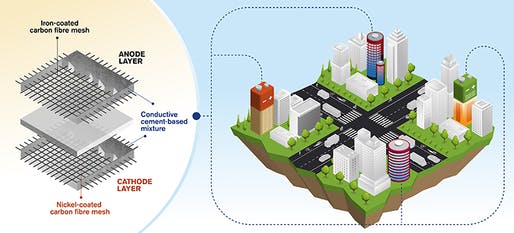
Researchers at Chalmers University of Technology in Sweden have published unique research into the idea of rechargeable batteries made from cement. The team, led by Dr Emma Zhang and Prof Luping Tang at the institution’s Department of Architecture and Civil Engineering, believes the development of this technology may yield a future where 20-storey concrete buildings can store energy as one giant battery.
The concept for Chalmers’ battery system begins with a cement-based mixture, to which small amounts of short carbon fibres are added to increase the material’s conductivity. A metal-coated carbon fibre mesh is then embedded within the mixture, with iron for the anode and nickel for the cathode, forming a high-strength battery system on an architectural or urban scale.
The research, published in the scientific journal Buildings, estimates that the new battery’s capacity performs 10 times higher than earlier attempts at concrete batteries. The energy density of the battery, seven watthours per square metre, is still low in comparison to commercial batteries. However, the team believes this is negated by the large volumes at which the battery can be constructed when used in a building’s structural and façade systems.
If used at scale, the researchers see the technology as offering an alternative response to the energy crisis. As concrete is one of the world’s most common, but least environmentally friendly building materials, the application of functions such as energy storage could offer a new dimension to how concrete is used in future buildings.
“We have a vision that in the future this technology could allow for whole sections of multi-storey buildings made of functional concrete. Considering that any concrete surface could have a layer of this electrode embedded, we are talking about enormous volumes of functional concrete,” says Zhang.
The team points to the battery’s recharging capability as a vehicle for multiple applications. Aside from energy storage, the system could power LEDs, provide 4G connections in remote areas or offer cathodic protection against corrosion in concrete infrastructure.
“It could also be coupled with solar cell panels for example, to provide electricity and become the energy source for monitoring systems in highways or bridges, where sensors operated by a concrete battery could detect cracking or corrosion,” Zhang explains.
Though promising, the research remains at an early stage. The team is now working on solutions to technical questions such as how the service life of the batteries could be prolonged to match those of concrete structures, and how the material may be recycled.
“Since concrete infrastructure is usually built to last 50 or even 100 years, the batteries would need to be refined to match this, or to be easier to exchange and recycle when their service life is over,” says Zhang. “For now, this offers a major challenge from a technical point of view.”
- An Architect report











